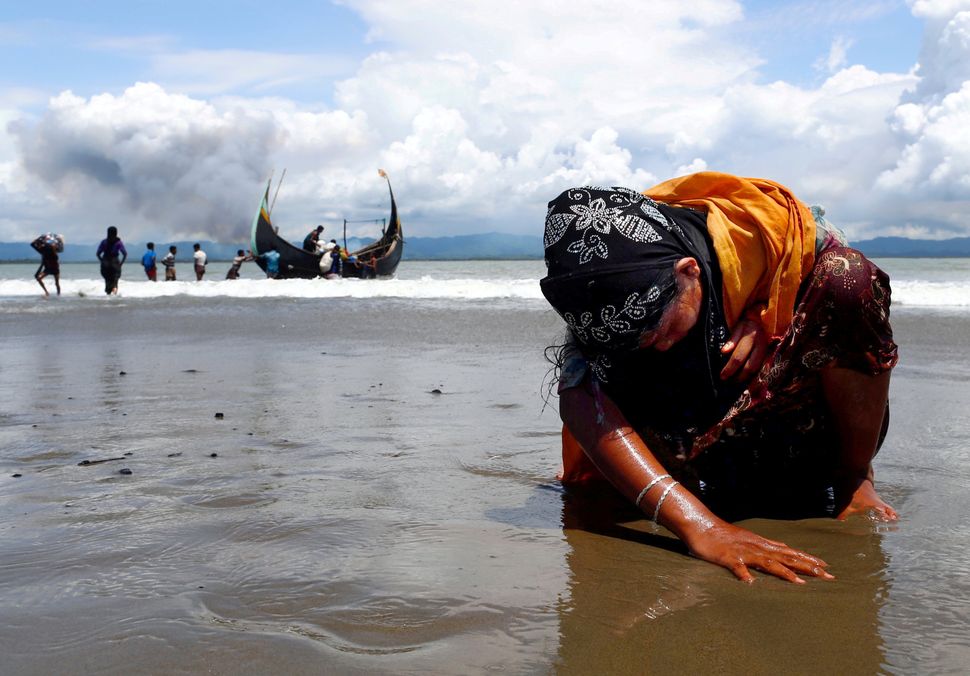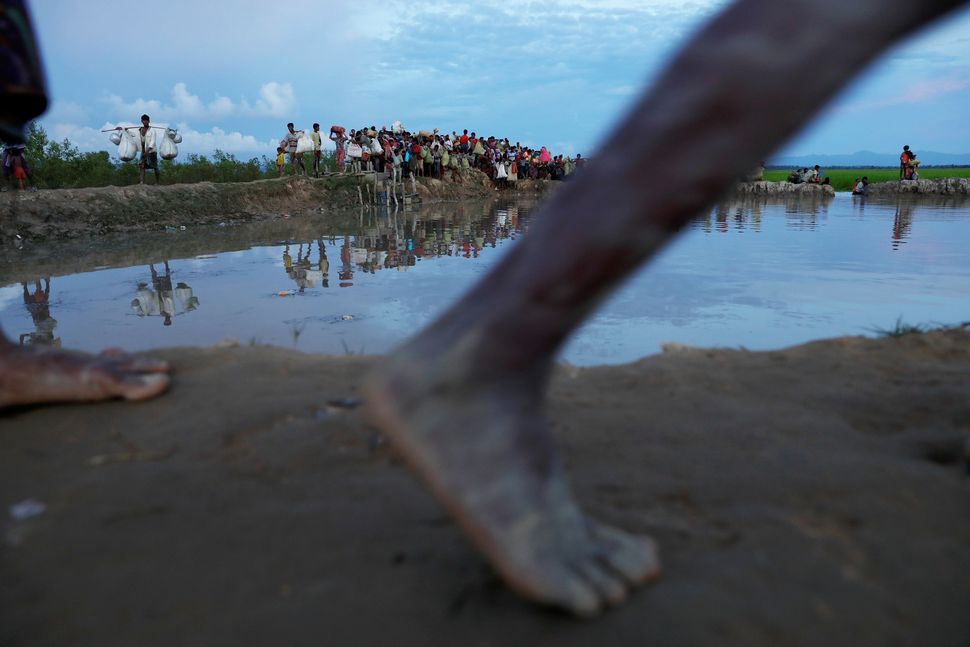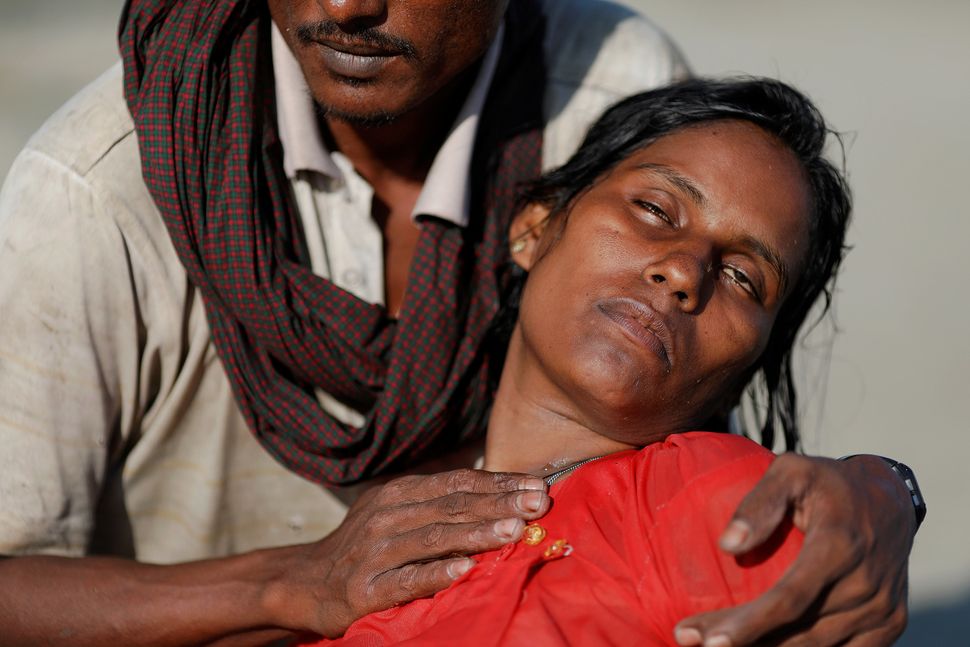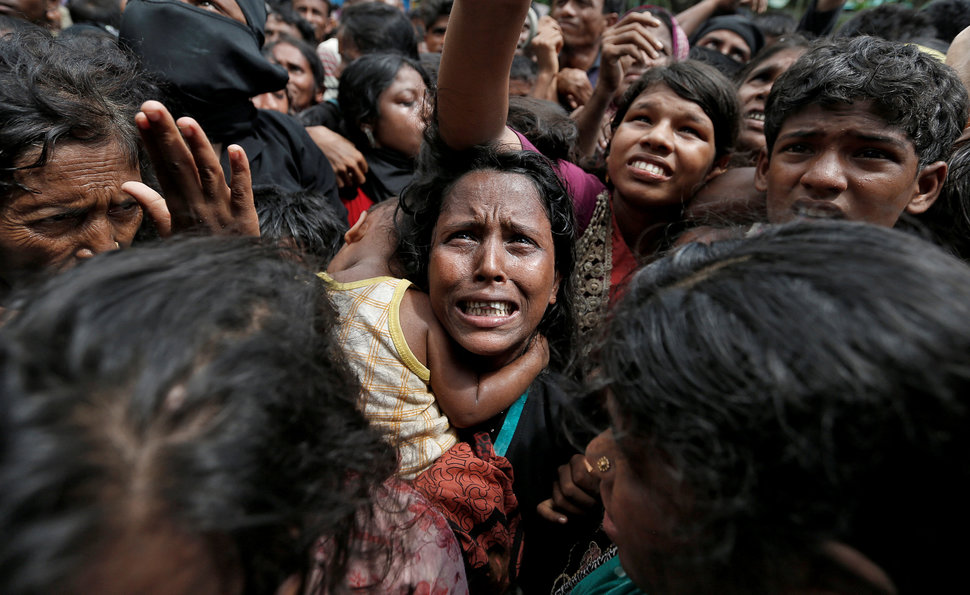help
Fundraising campaign by
julhas mia
-
US$0.00raised of $10,000.00 goal goal
No more donations are being accepted at this time. Please contact the campaign owner if you would like to discuss further funding opportunities
Campaign Story
A violent, ongoing campaign of state-sanctioned persecution has driven more than 655,000 Rohingya Muslims out of Myanmar’s Rakhine State in the last four months of 2017.
An attack by a group of Rohingya militants on government security posts in late August triggered the brutal purge by state forces, which humanitarian parties have decried as disproportionate and indiscriminate retaliation against the entire minority Muslim population.
By Sept. 24, at least 9,000 Rohingyas had died, according to Doctors Without Borders.
The hundreds of thousands of refugees have fled to neighboring Bangladesh to escape ethnic cleansing and crimes against humanity in Buddhist-majority Myanmar, where Rohingyas have extremely limited rights and have endured decades of government repression.
Gruesome reports by human rights groups document systematic assaults on Rohingyas and their villages, including rape, arson, shootings, beatings, and torture by state officials.
Overpopulated refugee camps in Cox’s Bazar, a Bangladeshi border city, are rapidly running out of basic resources as the number of new arrivals continues to swell.
Myanmar has repeatedly denied access to international authorities and investigators, including United Nations Special Rapporteur Yanghee Lee, making it difficult to grasp the scope of the unfolding crisis. And Burmese civil leader Aung San Suu Kyi, a now-disgraced Nobel Laureate, has downplayed the atrocities against Rohingyas as international cries for her to take action grow louder.
Suu Kyi and Gen. Aung Min Hlaing, head of the Burmese army, could be tried for genocide, U.N. High Commissioner for Human Rights Zeid Ra’ad Al Hussain said this week.
Below, photographs show Rohingya families fighting for survival as they restart their lives in Bangladesh.
The following images may be disturbing to some viewers.
 Danish Siddiqui / ReutersAn exhausted Rohingya refugee woman touches the shore after crossing the Bangladesh-Myanmar border by boat through the Bay of Bengal, in Shah Porir Dwip, Bangladesh on Sept. 11. Reuters photographer Danish Siddiqui: “It was a clear morning and I could see the several clouds of smoke in the background on the Myanmar side. After a few hours waiting on the beach the fishing boats started arriving with Rohingyas. This image was taken just after a family member of the Rohingya woman carried her from the boat. The exhausted Rohingya woman sat on the beach and put her hand to feel the shore after the long and dangerous journey from Myanmar.”
Danish Siddiqui / ReutersAn exhausted Rohingya refugee woman touches the shore after crossing the Bangladesh-Myanmar border by boat through the Bay of Bengal, in Shah Porir Dwip, Bangladesh on Sept. 11. Reuters photographer Danish Siddiqui: “It was a clear morning and I could see the several clouds of smoke in the background on the Myanmar side. After a few hours waiting on the beach the fishing boats started arriving with Rohingyas. This image was taken just after a family member of the Rohingya woman carried her from the boat. The exhausted Rohingya woman sat on the beach and put her hand to feel the shore after the long and dangerous journey from Myanmar.” Damir Sagolj / ReutersRohingya refugees who fled from Myanmar make their way through the rice field after crossing the border in Palang Khali, Bangladesh, on Oct. 9. Reuters photographer Damir Sagolj: “We were covering a tragic accident in which a boat carrying Rohingya refugees capsized and many, mostly children, died when we got a tip from colleagues that two hours drive to the north, thousands of refugees stranded on the border were finally crossing into Bangladesh. I rushed in that direction and made it just before the darkness to witness unreal scenes. Many thousands of people, carrying the sick and injured, the elderly and children, and their few possessions were slowly making their way through the mud and rice fields to the relative safety of Bangladesh. I thought I had witnessed enough tragedy that day for a lifetime, and yet it was just another day in a never-ending story for the Rohingya people fleeing Myanmar.”
Damir Sagolj / ReutersRohingya refugees who fled from Myanmar make their way through the rice field after crossing the border in Palang Khali, Bangladesh, on Oct. 9. Reuters photographer Damir Sagolj: “We were covering a tragic accident in which a boat carrying Rohingya refugees capsized and many, mostly children, died when we got a tip from colleagues that two hours drive to the north, thousands of refugees stranded on the border were finally crossing into Bangladesh. I rushed in that direction and made it just before the darkness to witness unreal scenes. Many thousands of people, carrying the sick and injured, the elderly and children, and their few possessions were slowly making their way through the mud and rice fields to the relative safety of Bangladesh. I thought I had witnessed enough tragedy that day for a lifetime, and yet it was just another day in a never-ending story for the Rohingya people fleeing Myanmar.” Damir Sagolj / ReutersRohingya refugees collapse from exhaustion after they arrive by a small wooden boat from Myanmar to the shore of Shah Porir Dwip, in Teknaf, near Cox’s Bazar in Bangladesh, on Oct. 1. Reuters photographer Damir Sagolj: “Unlike those who were crossing the Naf River under the cover of the darkness, this group of Rohingya refugees were landing at the beach of Shah Porir Dwip in the broad daylight. They were totally exhausted — I could only imagine what these people had been through before the rickety vessel brought them to Bangladesh. After landing, many just collapse. But not much later, as if awoken by survival instinct, they got back on their feet, collected children and the few possessions they brought with them, and continued by foot towards the refugee camps, a safe haven for those fleeing danger in Myanmar.”
Damir Sagolj / ReutersRohingya refugees collapse from exhaustion after they arrive by a small wooden boat from Myanmar to the shore of Shah Porir Dwip, in Teknaf, near Cox’s Bazar in Bangladesh, on Oct. 1. Reuters photographer Damir Sagolj: “Unlike those who were crossing the Naf River under the cover of the darkness, this group of Rohingya refugees were landing at the beach of Shah Porir Dwip in the broad daylight. They were totally exhausted — I could only imagine what these people had been through before the rickety vessel brought them to Bangladesh. After landing, many just collapse. But not much later, as if awoken by survival instinct, they got back on their feet, collected children and the few possessions they brought with them, and continued by foot towards the refugee camps, a safe haven for those fleeing danger in Myanmar.” Damir Sagolj / ReutersRoshid Jan, a Rohingya refugee who said she is not sure of her age, cries holding her son Muhammad Gyab at their shelter at the camp for widows and orphans inside the Balukhali camp near Cox’s Bazar, Bangladesh, on Dec. 5. Roshid Jan, who walked for 10 days with her five children to Bangladesh after soldiers burned their village, wept when she spoke about her missing husband. The religious leader in their Phansi village in Myanmar’s Rakhine State was accused of being a member of the Rohingya militants and arrested 11 months ago, she said. She had not seen him or heard about his fate since then. Now she lives with her five children and more than 230 others at camp for Rohingya widows and orphans. Reuters photographer Damir Sagolj: “Three hills away from the nearest road, in a dusty valley of Balukhali refugee camp, a patchwork of densely packed red tents hides an ocean of grief and pain. Some call it a red camp for its colour, others a long camp because of its shape but it’s best known for those who found shelter there. ‘This is a widows camp,’ its unofficial and energetic leader explained after I introduced myself. In about 50 tents, over 230 women and children live. There are no men. As I was listening the stories of widows and orphans this camp shelters, I realized it’s difficult to imagine a place with more sorrow than this. The camp seemed like a place in which the whole Rohingya tragedy is condensed.”
Damir Sagolj / ReutersRoshid Jan, a Rohingya refugee who said she is not sure of her age, cries holding her son Muhammad Gyab at their shelter at the camp for widows and orphans inside the Balukhali camp near Cox’s Bazar, Bangladesh, on Dec. 5. Roshid Jan, who walked for 10 days with her five children to Bangladesh after soldiers burned their village, wept when she spoke about her missing husband. The religious leader in their Phansi village in Myanmar’s Rakhine State was accused of being a member of the Rohingya militants and arrested 11 months ago, she said. She had not seen him or heard about his fate since then. Now she lives with her five children and more than 230 others at camp for Rohingya widows and orphans. Reuters photographer Damir Sagolj: “Three hills away from the nearest road, in a dusty valley of Balukhali refugee camp, a patchwork of densely packed red tents hides an ocean of grief and pain. Some call it a red camp for its colour, others a long camp because of its shape but it’s best known for those who found shelter there. ‘This is a widows camp,’ its unofficial and energetic leader explained after I introduced myself. In about 50 tents, over 230 women and children live. There are no men. As I was listening the stories of widows and orphans this camp shelters, I realized it’s difficult to imagine a place with more sorrow than this. The camp seemed like a place in which the whole Rohingya tragedy is condensed.” Anadolu Agency via Getty ImagesRohingya Muslims who fled from ongoing military operations in Myanmar’s Rakhine State make their way through muddy water after crossing the Bangladesh-Myanmar border in Cox’s Bazar, Bangladesh, on Sept. 1.
Anadolu Agency via Getty ImagesRohingya Muslims who fled from ongoing military operations in Myanmar’s Rakhine State make their way through muddy water after crossing the Bangladesh-Myanmar border in Cox’s Bazar, Bangladesh, on Sept. 1. Mohammad Ponir Hossain / ReutersHamida, a Rohingya refugee woman, cries as she holds her 40-day-old son, who died as a boat capsized on the shore of Shah Porir Dwip, in Teknaf, Bangladesh, on Sept. 14. Reuters photographer Mohammad Ponir Hossain: “I was taking pictures of exhausted refugees on the beach when I heard an auto-rickshaw driver shouting that a boat had capsized. I rushed to the spot and found people crying over the dead body of a child. I took a picture of Hamida, cradling the tiny pale body of her child, Abdul Masood. He appears to have died as the survivors scrambled through the crashing waves to shore. Hamida’s husband Nasir Ahmed carried his son away from the crowd. The couple’s other son survived the accident. These people are so desperate that they are risking their lives to escape Myanmar. The pictures show what is going on here.”
Mohammad Ponir Hossain / ReutersHamida, a Rohingya refugee woman, cries as she holds her 40-day-old son, who died as a boat capsized on the shore of Shah Porir Dwip, in Teknaf, Bangladesh, on Sept. 14. Reuters photographer Mohammad Ponir Hossain: “I was taking pictures of exhausted refugees on the beach when I heard an auto-rickshaw driver shouting that a boat had capsized. I rushed to the spot and found people crying over the dead body of a child. I took a picture of Hamida, cradling the tiny pale body of her child, Abdul Masood. He appears to have died as the survivors scrambled through the crashing waves to shore. Hamida’s husband Nasir Ahmed carried his son away from the crowd. The couple’s other son survived the accident. These people are so desperate that they are risking their lives to escape Myanmar. The pictures show what is going on here.” Paula Bronstein via Getty ImagesA man struggles to carry supplies across a stream as the monsoon rains continue to make life miserable for the displaced Rohingya on Sept. 17 in Kutupalong, Cox’s Bazar, Bangladesh.
Paula Bronstein via Getty ImagesA man struggles to carry supplies across a stream as the monsoon rains continue to make life miserable for the displaced Rohingya on Sept. 17 in Kutupalong, Cox’s Bazar, Bangladesh. Damir Sagolj / ReutersArif Ullah, who said his village was burned down and his relatives were killed by Myanmar soldiers, comforts his wife Shakira who collapsed from exhaustion as Rohingya refugees arrive by a wooden boat from Myanmar to the shore of Shah Porir Dwip, in Teknaf, near Cox’s Bazar in Bangladesh, on Oct. 1. Reuters photographer Damir Sagolj: “That morning, a group of Rohingya refugees crossed the Bay of Bengal on a rickety, wooden boat, for landings at Shah Porir Dwip, a village at the mouth of the Naf River. Most of the refugees, exhausted from the trip, collapsed after finally reaching the shores of Bangladesh. Shakira, unable to stand on her own, rested in her husband’s arms for some 10 to 15 minutes before getting up and continuing on foot towards a relief center nearby.”
Damir Sagolj / ReutersArif Ullah, who said his village was burned down and his relatives were killed by Myanmar soldiers, comforts his wife Shakira who collapsed from exhaustion as Rohingya refugees arrive by a wooden boat from Myanmar to the shore of Shah Porir Dwip, in Teknaf, near Cox’s Bazar in Bangladesh, on Oct. 1. Reuters photographer Damir Sagolj: “That morning, a group of Rohingya refugees crossed the Bay of Bengal on a rickety, wooden boat, for landings at Shah Porir Dwip, a village at the mouth of the Naf River. Most of the refugees, exhausted from the trip, collapsed after finally reaching the shores of Bangladesh. Shakira, unable to stand on her own, rested in her husband’s arms for some 10 to 15 minutes before getting up and continuing on foot towards a relief center nearby.” Cathal McNaughton / ReutersA security officer attempts to control Rohingya refugees waiting to receive aid in Cox’s Bazar, Bangladesh, on Sept. 21. Reuters photographer Cathal McNaughton: “During my first days at the camps it was chaotic. No infrastructure was in place for the distribution of the aid that arrived throughout the day. Men would fight children for aid packages. Children would wrestle with grandmothers for rice. Eventually the security forces moved in with sufficient numbers to try and restore order. To witness people getting beaten as they scrambled for food is indescribable.”
Cathal McNaughton / ReutersA security officer attempts to control Rohingya refugees waiting to receive aid in Cox’s Bazar, Bangladesh, on Sept. 21. Reuters photographer Cathal McNaughton: “During my first days at the camps it was chaotic. No infrastructure was in place for the distribution of the aid that arrived throughout the day. Men would fight children for aid packages. Children would wrestle with grandmothers for rice. Eventually the security forces moved in with sufficient numbers to try and restore order. To witness people getting beaten as they scrambled for food is indescribable.”- Dear/Madam...please give me donation and save the Rohinga people.
Subscribe to The Morning Email.
Wake up to the day's most important news.
Rewards
www.julhasmiaweebly.com
Organizer
- julhas mia
- Campaign Owner
- Netrokona, BD
Save the muslim rohiga
Update posted by julhas mia at 06:25 ampleas help the muslim rohinga.





